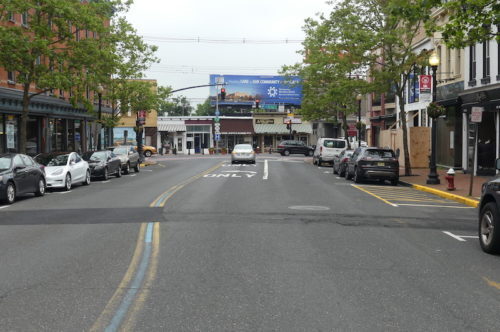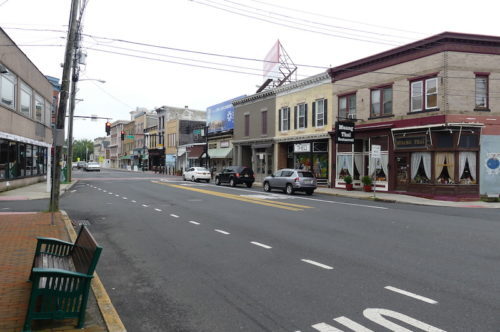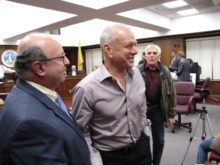
By JOHN T. WARD

Not in his office, says developer Steve Denholtz, whose multi-state empire has been devouring borough properties — including three that would fit in nicely with a project offering panoramic Navesink River views from downtown.
Then again, that doesn’t mean one might not happen, Denholtz tells redbankgreen.


The properties sit just east of a string of structures, many of them more than century old, that block the view of the Navesink from the northern end of Broad Street.
The deal was closed just three weeks after Denholtz obtained planning board approval for a 10-unit luxury condo project called Southbank, located just west of properties that would be critical to a Broad-to-the-river project.
Since at least the 1930s, local merchants, residents, town officials and others have mused about eliminating the strip to create a spectacular river vista. But such dreams have been repeatedly thwarted for one reason or another, including the reluctance of owners to sell.
Denholtz Properties’ chief executive Steve Denholtz acknowledges the acquisition of the Muang Thai and florist buildings constitute “a very unusual purchase” for the firm, which specializes in large, multi-tenant office buildings and industrial parks in New Jersey and Florida.
So, does the firm, with hundreds of millions of dollars worth of real estate in its portfolio, have a plan to connect its new holdings? A Broad-to-the-river plan, perhaps?
“No,” Denholtz told redbankgreen Thursday. But here’s the rest of the conversation on that point:
Denholtz: Well, you know it would be great for Red Bank, but it’s so difficult. You have so many landowners.
Look, I mean, if you’re asking me if I dream of it, yeah, I think it’s a great dream. But to make it happen is pretty daunting.
redbankgreen: So you don’t have any big plans for that block at present?
Denholtz: I wouldn’t go that far. We’re always looking at it. But once we start the Southbank building, I think that will be the end of that speculation, because without including Southbank into it, I don’t think it can happen. So it’s a little bit of a fantasy right now, but we’ll see.
We asked Mayor Pasquale Menna if he knew of anything brewing regarding Broad-to-river, and he was guarded, saying he “would like to defer the conversation a little bit” into the future.
“There’s a couple of pieces, and I don’t mean real estate, that would have to fall into place” if the idea is to ever see the light of day, he said. “I’ll just leave it at that.”
No proposals for the properties have been filed with the borough planning and zoning office, said secretary Dina Anastasio.
The 60-employee Denholtz firm has been on an investment spree in town for the last two years. It paid $3.2 million in 2017 for 116 Chestnut Street and moved its headquarters there from Matawan; it’s now wrapping up an extensive overhaul of the property.
At the same time, construction of Denholtz’s massive Rail @ Red Bank project is underway on a site that abuts both its HQ and the borough train station, with plans for 45 apartments, 6,000 square feet of retail and an interior parking garage.
In April, Denholtz paid $2.55 million for 137 Broad Street, a two-storefront building that briefly housed a Staples office supply store but is now half-occupied by Capitol Securities and half-vacant.
Denholtz, an Oceanport resident whose late father, Jack Denholtz, founded the company as a homebuilder in 1954, says he’s firmly sold on Red Bank.
“The deeper we’ve gotten into it, the more I’ve fallen in love with it,” he said. “There’s a real soul to the town, a real community there.” Other real estate investors are catching on to the potential, especially on the West Side near the station, he said.
At the same time, Denholtz Properties, which recently changed its name from Denholtz Associates, has been reorienting itself. While keeping its industrial portfolio, which comprises roughly half the company’s assets, he said, the firm has begun shifting its investments away from the giant suburban office market to properties in downtown Tampa, Orlando and Red Bank, among other urban locales, Denholtz said.
“To be down at the train station is invigorating,” Denholtz told redbankgreen. “It’s re-energized everybody at the company. It’s so tangible. When we moved, it was just immediate. It didn’t take us 10 minutes to know we had done the right thing.”
To celebrate its move to the new HQ, the firm threw a party earlier this month in a tent next door that attracted Menna and Governor Phil Murphy among the guests.
Menna told redbankgreen that he would like to see a Broad-to-the-river project finally come to fruition after decades of “logistical issues” that have prevented the “tremendous asset” of the Navesink from being utilized.
“We’re a river town, and yet people come here and don’t know there’s a river there,” he said. “So there’s potential.”
At one time, the street now known as Broad was the only one in town that ran down the the river, according to a history published in 1911 by the now-defunct Red Bank Register.
Notably, what’s now the Southbank property has previously been seen as key to a Broad-to-the-river project.
In 2017, the vacant site, on the corner of Boat Club Court and Union Street, was briefly under option for purchase by Jetsun Enterprises, a short-lived venture whose principals spoke privately of using it in an ambitious river-view project. That plan never got off the ground, and Jetsun vanished.
The planning board’s approval of Denholtz’s Southbank project came almost 50 years to the day after then-Mayor Daniel O’Hern drew fire from Leon Levinson, the owner of a hardware store at 2 West Front Street, over O’Hern’s efforts to push through a Broad-to-the-river project.
O’Hern was seeking council approval for $65,000 to buy five buildings, including Levinson’s, that would be razed for the project, which had been a centerpiece of his 1968 election campaign, according to the Register.





















